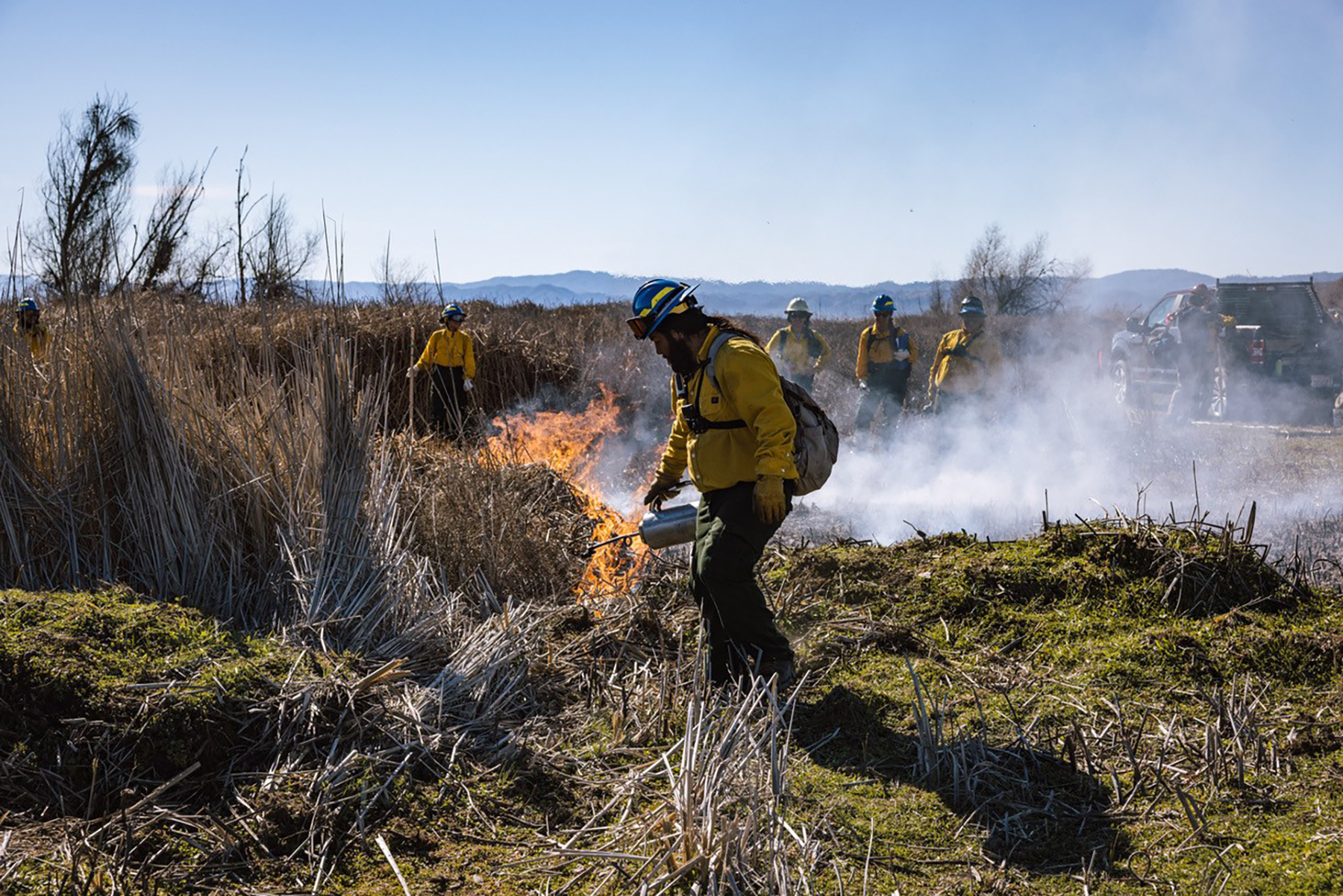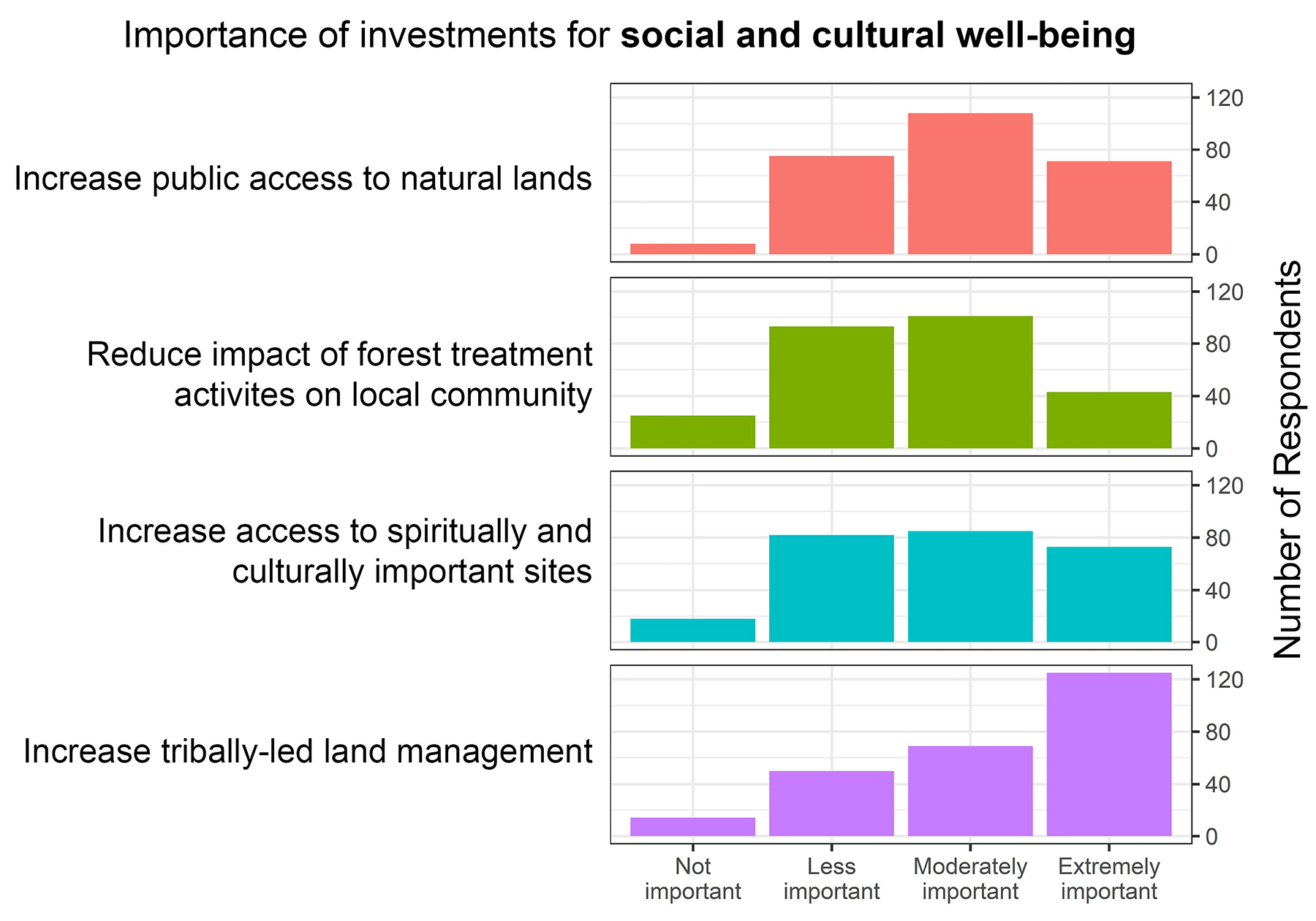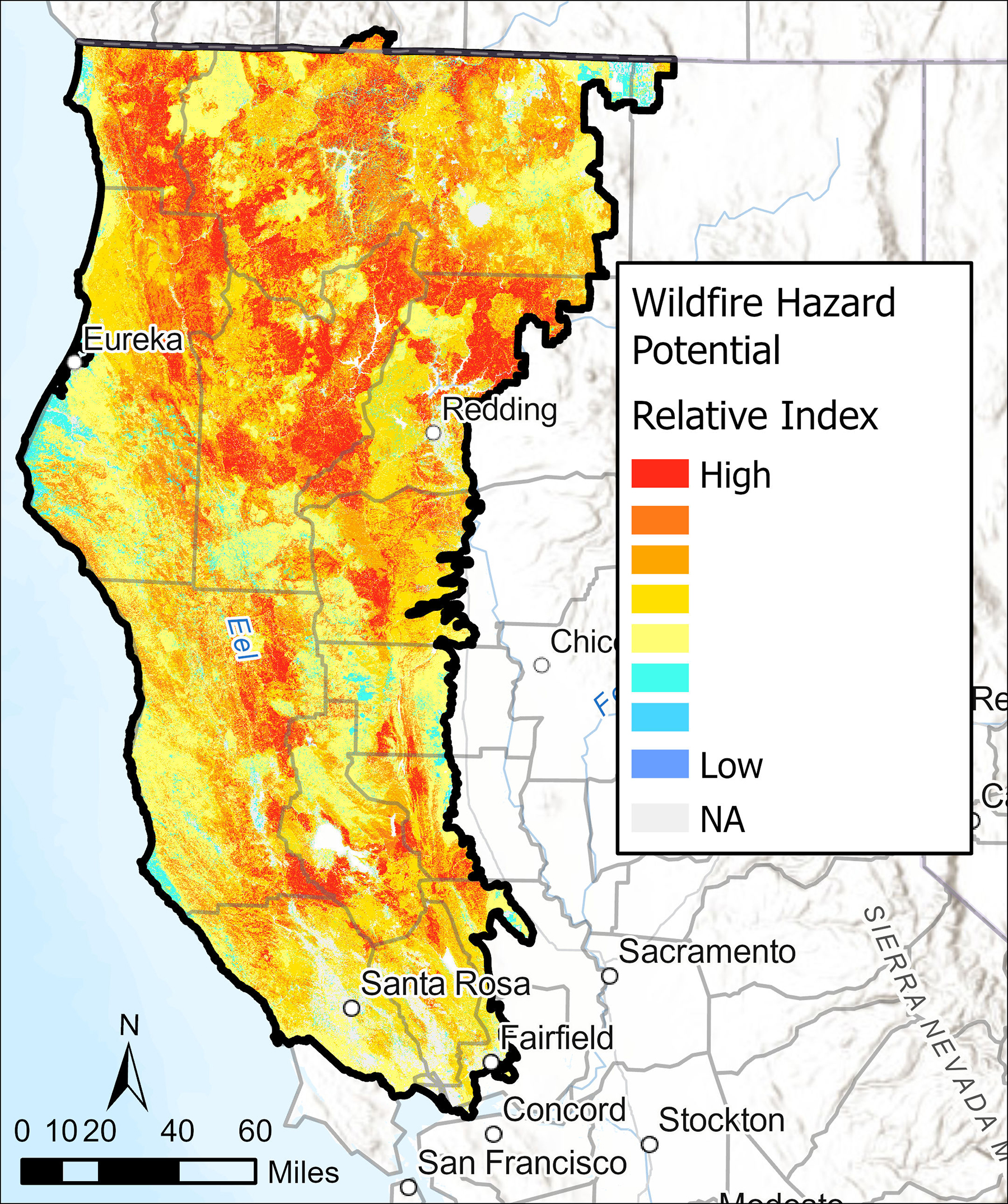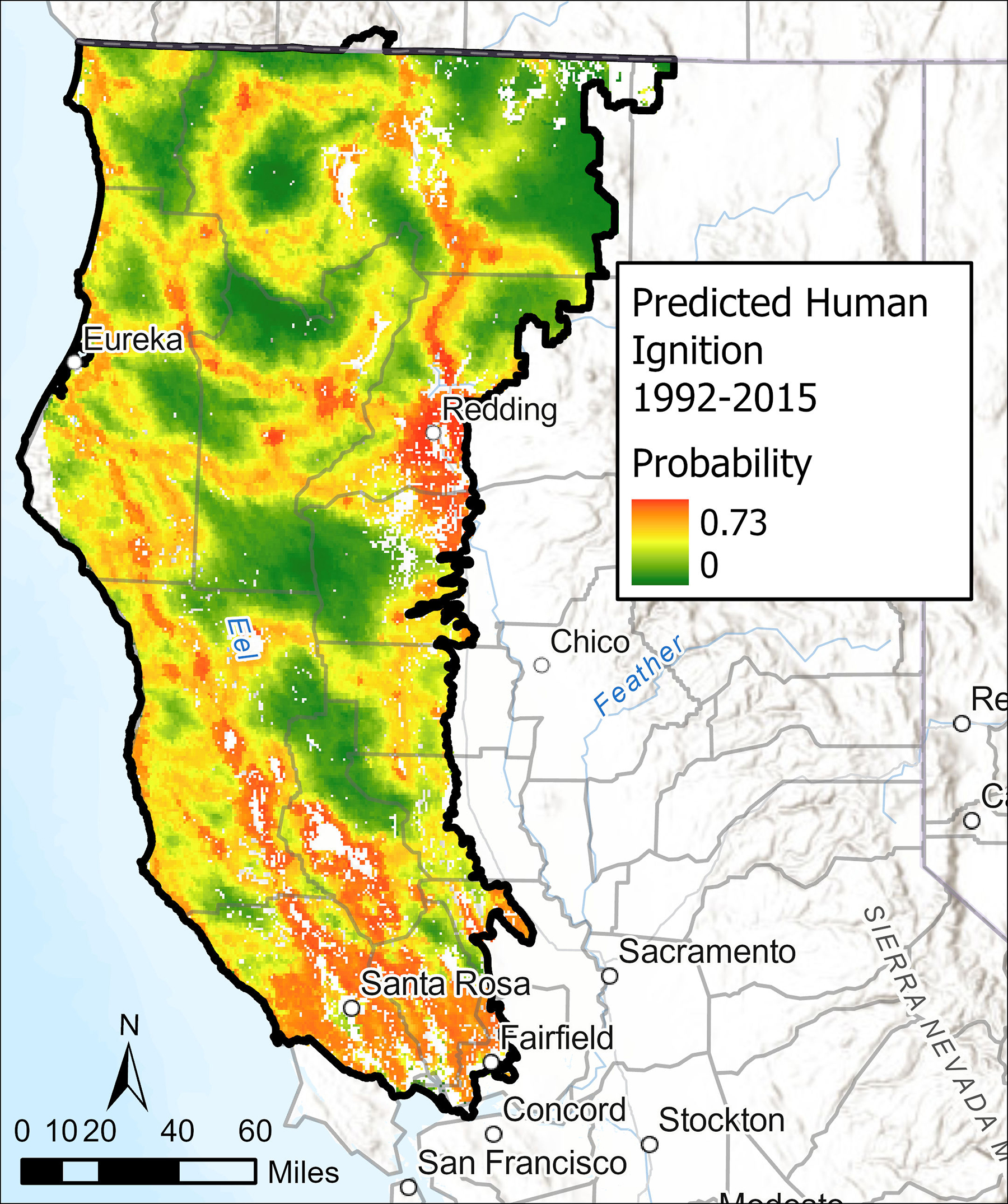Northern California Regional Profile
Resilient and Fire-Safe Communities

photo credit: Sashwa Burrous
Overview
As the Northern California region prepares for a future of increasing fire risk, communities are working to mitigate fire hazard and increase emergency preparedness. One challenge to adapting is that areas that did not experience high fire risk tend to have limited public awareness about how to live with fire and less capacity to increase fire preparedness than areas which have historically contended with wildfire. Furthermore, many rural communities in the region are socioeconomically disadvantaged and have aging populations, which makes it harder to do proactive work to mitigate wildfire hazard or to recover after disasters occur. Home hardening is critically needed in many areas, but many residents cannot afford costly home retrofitting. Although there are low-cost strategies for mitigating wildfire risk, such as modifying landscaping, placing screens on ventilations, and keeping flammable materials away from homes, many residents are not aware of these recommended practices. One solution for this is increasing public education around both home hardening and defensible space recommendations. There is also a need to increase public awareness on preventing human ignitions, as accidental ignitions have been the cause of some recent destructive wildfires in the region.
Safety during wildfires and other emergencies is a concern for many communities across the region, especially in remote areas where there are limited roads for ingress and egress. Efforts are being made to develop evacuation plans and to increase secondary route access through private road agreements between neighbors, but in many areas limited financial resources or topographical challenges make building additional road infrastructure infeasible. Similar to other regions in California, there has been continued development in the wildland-urban interface where there is high fire hazard. Certain counties, especially in the southern part of the region and near Redding in Shasta County, have been especially susceptible to this. This is a concern because development in the wildland-urban interface increases the probability of human ignitions in densely vegetated areas and increases the risk of danger to communities if natural- or human-caused wildfire does occur.
One aspect of emergency preparedness that is particularly challenging for the Northern California region is communication to remote communities. Many communities do not have access to broadband internet and have limited cell reception. As a result, it can be hard for residents to access information or receive emergency notifications. Many communities rely on local radio stations as the primary alert system, though in some remote areas, it is even hard for radio signals to get through. Areas that normally have functioning communication networks that depend on websites and social media also need to have a back-up plan prepared for communities to know how to respond in emergencies when electricity is lost.
In order to be resilient to wildfire, communities also need to be capable of recovering after disaster occurs. One interviewee described how in their experience there has been tremendous emergency response to suppress fire, but afterward there are limited resources, technical expertise, and other support for communities that need to rebuild. Recovery is becoming increasingly challenging as many homeowners across the region have lost access to fire insurance due to policies being dropped or rates becoming unaffordable. As a result, when disaster occurs, many residents are unable to rebuild and end up leaving the area. This displacement has put greater strain on limited housing resources in other areas and also impacts the recovery of the community that remains. Several interviewees noted that there is also a need for community resilience efforts to address mental health because many people in the region have experienced trauma from recent wildfire events.
Despite these challenges, there are many new initiatives led by both public and private organizations that are effectively increasing community resilience across the region. These organizations are empowering communities by providing technical expertise, public education, and increased access to resources, including grant opportunities. New fire safe councils and prescribed burn associations are forming across the region. Many neighborhoods are also working toward achieving Firewise Community designation to increase the safety of their community and to access insurance discounts. However, interviewees expressed concerns that many positions and projects are dependent on temporary funding from legislation or grants, and the long-term work that needs to be done to respond to the growing wildfire crisis requires more permanent funding support. Interviewees also expressed concern that entities with greater existing capacity are often more successful in competing for grants and forming partnerships, whereas counties and individual organizations that have less capacity continue to struggle to access resources.
Some regional organizations are investing in building community capacity that can then be self-sustaining. For example, the Watershed Research and Training Center provides family-friendly community-based training in implementing prescribed fire. This has been effective in developing local workforce capacity, as well as providing broad public education around living with fire. One interviewee noted that it can be challenging to do community engagement work because this work is often not recognized as something that needs funding and is worth investing in. Also, funding and metrics for success tend to be tied to quantifiable outcomes like acres of vegetation treated, and it can be harder to quantify the return on investment that comes from empowering communities. However, some public agencies and other land management organizations have recently staffed more public affairs and community outreach positions.
In some cases, community resilience and recovery efforts have been notably led by people who were personally impacted by recent fire events. For example, after the 2015 Valley Fire devastated Lake County, took four lives, destroyed nearly 1,281 homes, and caused an estimated $1.5 billion in losses, a community member who lost their house was motivated to start a non-profit called the Seigler Springs Community Redevelopment Association that has since grown in capacity and continued to provide disaster care management, economic grant development, and community development with a particular focus on wildfire adaptation. Such examples of disaster leading to stronger regrowth demonstrate the capacity for resilience that exists in the region.
Stakeholder Perspectives

Reducing fuel loads was the potential area of investment rated as most important for increasing fire safety and preparedness with the majority of stakeholders rating it as extremely important. This was closely followed by investing in home hardening and defensible space, as well as improving infrastructure for emergencies, protecting critical infrastructure, and maintaining strategic fuel breaks. Updating building codes was the only potential area of investment that was considered on average less than moderately important.

Survey respondents were also asked to consider investments focused specifically on social and cultural well-being. Increasing triballyled land management was considered to be the most important area of investment in this category with a high number of survey respondents rating it as extremely important. All other options suggested for increasing community well-being were rated on average as less than moderately important, though individual responses widely varied.
Resource Conditions


Measuring wildfire hazard potential (top) can help prioritize locations of fuel treatments. In the Regional Resource Kit, this metric focuses specifically on potential for fires that may be difficult for suppression operations to control based on models of how fire will behave. High potential for wildfire hazard exists in all of Northern California’s counties. Hazard potential is especially high and concentrated in Del Norte County, northeastern Humboldt County, eastern Trinity and northern Shasta Counties. The Regional Resource Kit ignition probability metrics reference a model that used recent (1992-2015) ignition records and environmental data, including human settlement, climate, fuels, and topographical variables, to predict human-caused ignition probability (bottom). Because population density is low across most of Northern California, human-caused ignitions are most likely to occur along major roads and near population centers, such as Redding and Santa Rosa.
